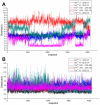Molecular dynamics simulation of the complex PBP-2x with drug cefuroxime to explore the drug resistance mechanism of Streptococcus suis R61
- PMID: 22563422
- PMCID: PMC3338546
- DOI: 10.1371/journal.pone.0035941
Molecular dynamics simulation of the complex PBP-2x with drug cefuroxime to explore the drug resistance mechanism of Streptococcus suis R61
Abstract
Drug resistance of Streptococcus suis strains is a worldwide problem for both humans and pigs. Previous studies have noted that penicillin-binding protein (PBPs) mutation is one important cause of β-lactam antibiotic resistance. In this study, we used the molecular dynamics (MD) method to study the interaction differences between cefuroxime (CES) and PBP2x within two newly sequenced Streptococcus suis: drug-sensitive strain A7, and drug-resistant strain R61. The MM-PBSA results proved that the drug bound much more tightly to PBP2x in A7 (PBP2x-A7) than to PBP2x in R61 (PBP2x-R61). This is consistent with the evidently different resistances of the two strains to cefuroxime. Hydrogen bond analysis indicated that PBP2x-A7 preferred to bind to cefuroxime rather than to PBP2x-R61. Three stable hydrogen bonds were formed by the drug and PBP2x-A7, while only one unstable bond existed between the drug and PBP2x-R61. Further, we found that the Gln569, Tyr594, and Gly596 residues were the key mutant residues contributing directly to the different binding by pair wise energy decomposition comparison. By investigating the binding mode of the drug, we found that mutant residues Ala320, Gln553, and Thr595 indirectly affected the final phenomenon by topological conformation alteration. Above all, our results revealed some details about the specific interaction between the two PBP2x proteins and the drug cefuroxime. To some degree, this explained the drug resistance mechanism of Streptococcus suis and as a result could be helpful for further drug design or improvement.
Conflict of interest statement
Figures







Similar articles
-
Mutations in Streptococcus pneumoniae penicillin-binding protein 2x: importance of the C-terminal penicillin-binding protein and serine/threonine kinase-associated domains for beta-lactam binding.Microb Drug Resist. 2012 Jun;18(3):314-21. doi: 10.1089/mdr.2012.0022. Epub 2012 Mar 28. Microb Drug Resist. 2012. PMID: 22455550
-
Comparative genomics study of multi-drug-resistance mechanisms in the antibiotic-resistant Streptococcus suis R61 strain.PLoS One. 2011;6(9):e24988. doi: 10.1371/journal.pone.0024988. Epub 2011 Sep 26. PLoS One. 2011. PMID: 21966396 Free PMC article.
-
M341I substitution of penicillin binding protein 2X contributes to the emergence of high-level penicillin resistant Streptococcus suis in China.Vet Microbiol. 2025 Jul;306:110569. doi: 10.1016/j.vetmic.2025.110569. Epub 2025 May 22. Vet Microbiol. 2025. PMID: 40414107
-
Penicillin-binding proteins and beta-lactam resistance.FEMS Microbiol Rev. 2008 Mar;32(2):361-85. doi: 10.1111/j.1574-6976.2007.00095.x. Epub 2008 Jan 29. FEMS Microbiol Rev. 2008. PMID: 18248419 Review.
-
A review of penicillin binding protein and group A Streptococcus with reduced-β-lactam susceptibility.Front Cell Infect Microbiol. 2023 Mar 31;13:1117160. doi: 10.3389/fcimb.2023.1117160. eCollection 2023. Front Cell Infect Microbiol. 2023. PMID: 37065204 Free PMC article. Review.
Cited by
-
Update on the Mechanisms of Antibiotic Resistance and the Mobile Resistome in the Emerging Zoonotic Pathogen Streptococcus suis.Microorganisms. 2021 Aug 18;9(8):1765. doi: 10.3390/microorganisms9081765. Microorganisms. 2021. PMID: 34442843 Free PMC article. Review.
-
Patterns of antimicrobial resistance in Streptococcus suis isolates from pigs with or without streptococcal disease in England between 2009 and 2014.Vet Microbiol. 2017 Aug;207:117-124. doi: 10.1016/j.vetmic.2017.06.002. Epub 2017 Jun 13. Vet Microbiol. 2017. PMID: 28757010 Free PMC article.
-
Streptococcus suis: Epidemiology and resistance evolution of an emerging zoonotic bacteria.One Health. 2025 Jun 16;21:101098. doi: 10.1016/j.onehlt.2025.101098. eCollection 2025 Dec. One Health. 2025. PMID: 40599646 Free PMC article. Review.
-
Exploring the Origin of Differential Binding Affinities of Human Tubulin Isotypes αβII, αβIII and αβIV for DAMA-Colchicine Using Homology Modelling, Molecular Docking and Molecular Dynamics Simulations.PLoS One. 2016 May 26;11(5):e0156048. doi: 10.1371/journal.pone.0156048. eCollection 2016. PLoS One. 2016. PMID: 27227832 Free PMC article.
-
New Characterization of Multi-Drug Resistance of Streptococcus suis and Biofilm Formation from Swine in Heilongjiang Province of China.Antibiotics (Basel). 2023 Jan 10;12(1):132. doi: 10.3390/antibiotics12010132. Antibiotics (Basel). 2023. PMID: 36671333 Free PMC article.
References
-
- Willenburg KS, Sentochnik DE, Zadoks RN. Human Streptococcus suis meningitis in the United States. N Engl J Med. 2006;354:1325–1325. - PubMed
-
- Wangkaew S, Chaiwarith R, Tharavichitkul P, Supparatpinyo K. Streptococcus suis infection: a series of 41 cases from Chiang Mai University Hospital. Journal of Infection. 2006;52:455–460. - PubMed
-
- Sakata H. Antibiotic susceptibility to parental antibiotics and penicillin-binding-protein genotype in Haemophilus influenzae isolated from children with invasive infection. The Journal of the Japanese Association for Infectious Diseases. 2011;85:26–30. - PubMed
-
- Wilke MS, Lovering AL, Strynadka NCJ. Beta-Lactam antibiotic resistance: a current structural perspective. Current opinion in microbiology. 2005;8:525–533. - PubMed
-
- Martel A, Baele M, Devriese L, Goossens H, Wisselink H, et al. Prevalence and mechanism of resistance against macrolides and lincosamides in Streptococcus suis isolates. Veterinary microbiology. 2001;83:287–297. - PubMed
Publication types
MeSH terms
Substances
LinkOut - more resources
Full Text Sources
Medical
Research Materials
Miscellaneous

